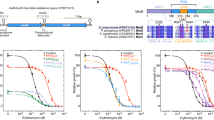Summary
Plasmids were constructed containing the regulatory regions and N-terminal portions of ermC and of ermD, fused in phase with the coding sequence of the Escherichia coli lacZ gene. ermC and ermD are erythromycin (Em) inducible macrolide-lincosamide-streptogramin B resistance elements derived from Staphylococcus aureus and Bacillus licheniformis, respectively. The fusion plasmids were introduced into B. subtilis and used to study ermC and ermD regulation. In both cases, β-galactosidase synthesis could be induced by low levels of Em. Induction was prevented by introduction of ole-2, a chromosomal mutation which decreases ribosomal affinity for Em. Induction also did not occur in the presence of intact copies of ermC, suggesting that prior or concomitant methylation of 23S rRNA, a treatment known to decrease ribosomal affinity for Em, was capable of interfering with ermC and ermD induction. These experiments are consistent with the translational attenuation model of ermC regulation, and together with other evidence, suggest that ermD is regulated by a similar mechanism.
Similar content being viewed by others
References
Casadaban MJ, Chou J, Cohen SN (1980) In vitro gene fusions that join an enzymatically active β-galactosidase segment to amino-terminal fragments of exogenous proteins: Escherichia coli plasmid vectors for the detection and cloning of translational initiation signals. J Bacteriol 143:971–980
Contente S, Dubnau D (1979) Characterization of plasmid transformation in Bacillus subtilis: Kinetic properties and the effect of DNA conformation. Mol Gen Genet 167:251–258
Craven GR, Steers E Jr, Anfinsen CB (1965) Purification, composition and molecular weight of the β-galactosidase of Escherichia coli K12. J Biol Chem 240:2468–2477
Docherty A, Grandi, Grandi G, Grandi R, Gryczan TJ, Shivakumar AG, Dubnau D (1981) Naturally occurring macrolide-lincosamide-streptogramin B resistance in Bacillus licheniformis. J Bacteriol 145:129–137
Dubnau D (1984) Translational attenuation: The regulation of bacterial resistance to the macrolide-lincosamide-streptogremin B antibiotics. In: Fasman G (ed) Critical reviews in biochemistry. CRC Press, Inc, Cleveland, Ohio
Dubnau D, Davidoff-Abelson R (1971) Fate of transforming DNA following uptake by competent Bacillus subtilis. I. Formation and properties of the donor-recipient complex. J Mol Biol 56:209–221
Gryczan TJ, Contente S, Dubnau D (1978) Characterization of Staphylococcus aureus plasmids introduced by transformation into Bacillus subtilis. J Bacteriol 134:318–329
Gryczan TJ, Grandi G, Hahn J, Grandi R Dubnau D (1980a) Conformational alteration of mRNA structure and the post-transcriptional regulation of erythromycin-induced drug resistance. Nucleic Acids Res 8:6081–6097
Gryczan TJ, Hahn J, Contente S, Dubnau D (1982) Replication and incompatibility properties of the plasmid pE194 in Bacillus subtilis. J Bacteriol 152:722–735
Gryczan TJ, Israeli-Reches M, Del Bue M, Dubnau D (1984) DNA sequence and regulation of ermD, a macrolide-lincosamide-streptogramin B resistance element from Bacillus licheniformis. Mol Gen Genet 194:349–356
Gryczan TJ, Shivakumar AG, Dubnau D (1980b) Characterization of chimeric plasmid cloning vehicles in Bacillus subtilis. J Bacteriol 141:246–253
Hahn J, Grandi G, Gryczan TJ, Dubnau D (1982) Translational attenuation of ermC: A deletion analysis. Mol Gen Genet 186:204–216
Hofemeister J, Israeli-Reches M, Dubnau D (1983) Integration of plasmid pE194 at multiple sites on the Bacillus subtilis chromosome. Mol Gen Genet 189:58–68
Horinouchi S, Byeon W, Weisblum B (1983) A complex attenuator regulates inducible resistance to macrolides, lincosamides, and streptogramin type B antibiotics in Streptococcus sanguis. J Bacteriol 154:1252–1262
Horinouchi S, Weisblum B (1980) Posttranscriptional modification of mRNA conformation: mechanism that regulates erythromacin-induced resistance. Proc Natl Acad Sci USA 77:7079–7083
Horinouchi S, Weisblum B (1981) The control region for erythromycin resistance: Free energy changes related to induction and mutation to constitutive expression. Mol Gen Genet 182:341–348
Lai C-J, Dahlberg JE, Weisblum B (1973a) Structure of an inducibly methylatable nucleotide sequence in 23S ribosomal ribonucleic acid from erythromycin-resistant Staphylococcus aureus. Biochemistry 12:457–460
Lai C-J, Weisblum B (1971) Altered methylation of ribosomal RNA in an erythromycin-resistant strain of Staphylococcus aureus. Proc Natl Acad Sci USA 68:856–860
Lai C-J, Weisblum B, Fahnestock SR, Nomura M (1973b) Alteration of 23S ribosomal RNA and erythromycin-induced resistance to lincomycin and spiramycin in Staphylococcus aureus. J Mol Biol 74:67–72
Murray CL, Rabinowitz JC (1982a) Species specific translation: Characterization of B. subtilis ribosome binding sites. In: Ganesan AT, Chang S, Hoch JA (eds) Molecular cloning and gene regulation in Bacilli. Academic Press, Inc, New York, pp 271–285
Murray CL, Rabinowitz JC (1982b) Nucleotide sequences of transcription and translation initiation regions in Bacillus phage ϕ29 early genes. J Biol Chem 257:1053–1062
Scheer-Abramowitz J, Gryczan TJ, Dubnau D (1981) Origin and mode of replication of plasmids pE194 and pUB110. Plasmid 6:67–77
Schleiff RF, Wensink PC (1981) Practical methods in molecular biology. Springer-Verlag, New York, Inc
Shivakumar AG, Dubnau D (1981) Characterization of a plasmid-specified ribosome methylase associated with macrolide resistance. Nucleic Acids Res 9:2549–2562
Shivakumar AG, Hahn J, Grandi G, Kozlov Y, Dubnau D (1980) Posttranscriptional regulation of an erythromycin resistance protein specified by plasmid pE194. Proc Natl Acad Sci USA 77:3903–3907
Tanaka T, Weisblum B (1975) Construction of a colicin El-R factor composite plasmid in vitro: means for amplification of deoxyri-bonucleic acid. J Bacteriol 121:354–362
Weisblum B, Graham MY, Gryczan T, Dubnau D (1979) Plasmid copy number control: Isolation and characterization of high-copy-number mutants of plasmid pE194. J Bacteriol 137:635–643
Weisblum B, Siddhikol C, Lai CJ, Demohn V (1971) Erythromycin-inducible resistance in Staphylococcus aureus: requirements for induction. J Bacteriol 106:835–847
Author information
Authors and Affiliations
Additional information
Communicated by A. Bukhari
Rights and permissions
About this article
Cite this article
Gryczan, T.J., Israeli-Reches, M. & Dubnau, D. Induction of macrolide-lincosamide-streptogramin B resistance requires ribosomes able to bind inducer. Molec. Gen. Genet. 194, 357–361 (1984). https://doi.org/10.1007/BF00425544
Received:
Issue Date:
DOI: https://doi.org/10.1007/BF00425544




